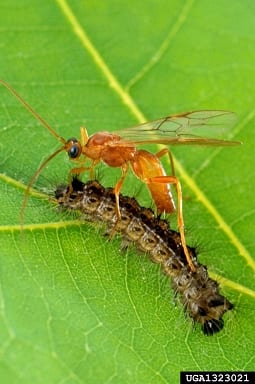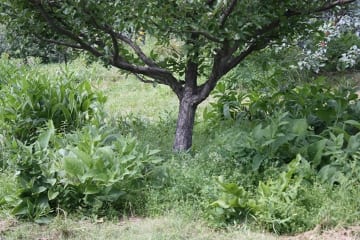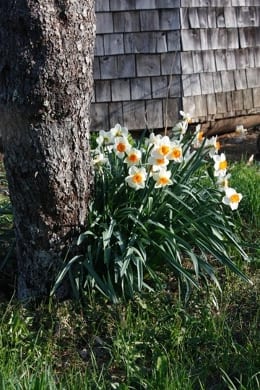The following excerpt is reprinted with the author’s permission from The Holistic Orchard, Chelsea Green Publishing (January 10, 2012).
by Michael Phillips
Permaculture people speak of two classes of plants to encourage within any gardenscape. Recognizing the role of dynamic accumulators and beneficial accumulators helps us bring specific plant interactions into focus.
Companion planting is far more than an old wives’ tale. All plants contribute to the ecosystem, even those we mistakenly call weeds. Deep-taprooted species draw minerals up from the subsoil; green tops die back at season’s end; root systems eventually pass on; fungi and company decompose the once vibrant botany. Minerals become available through the organic matter to other plants; these minerals have been “accumulated,” and so we now become conscious of the dynamic accumulator class of plants.
Similarly, a flowering plant like sweet cicely (Myrrhis odorata) provides nectar for an adult syrphid fly, which means that the adult female will be around in the ecosystem to lay a random egg on a fruit tree leaf to hatch into a syrphid larva that will consume aphids on the order of forty a day. The flowers of one have acted as a draw for certain pest-eating insects to the tree—thus accumulating the populations of good bugs—leaving you and me with an impressed awareness of the diversity brought on by beneficial accumulator species.
Plant Allies
One medicinal herb serves as an understory superstar in my orchard around freestanding apple and pear trees. First, however, we require the inevitable disclaimer: You are about to hear the many benefits of this particular plant . . . just know now, right off the bat, that once introduced to your ground, comfrey will likely be an indomitable force for many years to come. Digging it out—if you ever come up with a biological reason to change your mind—will be difficult. Please: Do not come back and blame me!
The marvel of comfrey from a fruit tree perspective begins with its deep-reaching root system, which effectively mines potassium, calcium, and other untapped minerals. Its leaves and stalks are flush with nutrient wealth, producing a lush plant that blossoms just after petal fall on apple trees in a cascading series of delightful pale purple-pink umbel florets. Bumblebees delight in this subsequent nectar source. As comfrey starts to set seed, it becomes carbon-heavy—and thus top-heavy—and soon falls in every random direction as living mulch, thereby suppressing grass growth and preventing it from becoming the dominant ground cover. A new round of herbal shoots from comfrey’s insistent roots responds to this sunlight opportunity, repeating this same cycle at least two times more in a given year. The circumference of a comfrey circle grows as the mother plant expands outward. The soil here becomes deep brown, even black, brimming with life force. Fruit tree feeder roots find this an irresistible invitation, totally unlike the reception provided by a dense sod where high carbon dioxide levels produced by fine grasses (in the process of root transpiration) proves disagreeable. Comfrey leaves room in the humus for trees to find full mycorrhizal connection. And to think—all you had to do was plant comfrey starts (root crowns) around the anticipated dripline of the tree to launch this self-renewing orchard plan.
A broad mix of species belongs under and within the vicinity of fruit trees. You can make deliberate choices here to reflect a certain look, or you can trust serendipity (enhanced by introduced species left to go to seed) to bring a diverse understory to the fore. Red clover has nitrogen-fixing capability, being a legume, which ties in nicely to comfrey’s need for high nitrogen . . . which in turn will be made available to fruit tree roots in the form of ammonium by the action of soil life. Legumes are noted as well for raising available phosphorus levels. The humble dandelion is especially adept at drawing potassium up. Chicory’s specialty is twofold: This plant accumulates zinc, and, when it dies, the hole left by the decaying root is an act of soil aeration in itself. Other plants like nettle, yarrow, and horsetail contribute similarly to this crescendo of specific nutrients. Are we tuning in to how a diverse understory contributes homegrown fertility to the orchard through organic matter cycled through the soil food web? Minerals are being mined and brought to the surface by this array of taprooted plants, and this will go on for a long, long time.
Woodsy herbs abet the fungal dominance we seek directly in the tree zone. In a sense, we could invent a new permaculture term here for plants like thyme, marjoram, and lavender, calling these mycorrhizal accumulators in their own right. The neatness of low-lying herbs will appeal to some of you more than the wild look found on my orchard acreage, and that’s okay. Less stout perennials will be smothered under the shovelfuls of crumbly compost thrown at the base of fruit trees each fall, whereas these woody-stemmed herbs can stand up to greater biological depths. Aromatic herbs also allow us to see the trunk, unlike tall lush growth right up against the stem of each tree. Daffodils planted in a ring, bulb touching bulb, about a foot out from a young sapling, serve this same purpose and more. These spring flowers absorb their light share before the tree reaches full leaf, after which the green growth from the bulb quickly fades away, leaving more openness right around the base of the tree. Daffodil bulbs turn out to be disagreeable to voles as well, which are basically voracious mouse cousins inclined to eat apple tree bark in late fall and winter, given the opportunity. Other culinary herbs including mints and chives are reputed to help with peach leaf curl and apple scab, but for the life of me I can’t envision how this lore relates to fungal disease cycles. Still, diversity rules, and I have planted less woodsy herbs out under the dripline of some of my fruit trees—the point being, yes, you can integrate an array of kitchen herbs in the orchard if you wish.
Bitter herbs like wormwood, southernwood, rue, hyssop, pennyroyal, and gentian have long been used for tree protection in still another way. These highly aromatic plants are sensed by fruit pests, creating olfactory confusion within the fruit guild. Such plant allies can be used more effectively in smaller fruit plantings than in more extensive commercial blocks. Plant knowledge like this can come into play in protecting highly desirable fruit or even in funneling insects toward sacrificial trap trees. Tansy and sage have a high camphor content that has been observed to deter codling moths. Nasturtium has a similar influence on woolly apple aphid, so if you happen to have susceptible rootstock, plant several around your apple and pear trees and enjoy a peppery nibble to boot.
Insect Allies
Numerous plants attract beneficial species of insects to the orchard ecosystem. Biodiversity comes into its own now, revealing all sort of fascinating nuances. Consider the self-contained world of an angelica plant in flower. Hundreds of pollinators—including an array of tiny wasps that parasitize the larvae or eggs of larger insects—feed on the nectar and pollen offered by angelica and similar wildflowers. It’s the other plants in the fruit guild that deliver balance in the populations of fruit pests by providing habitat for the good bugs.
Savvy commercial orchardists plant diversity strips of specific flowering plants within a solid block of trees to draw the predators and parasitoids that help keep other insect pests in check. The home orchard, on the hand, flourishes with diversity advantages by virtue of plants you’re already inclined to grow in garden areas. Wild corners should be granted due diligence—a dear friend once told me to always leave a place for the fairies to dwell. Hers was a diversity message, celebrating what we humans tend to dismiss as unsightly and unmanaged. Yet it’s the wildlings that truly shine as beneficial plant allies.

Some species of braconid wasps seek out moth eggs in which to lay their eggs, while others opt for a fleshier nursery to rear their young. This gypsy moth larva is a definite goner! Photo courtesy of Scott Bauer, USDA Agricultural Research Service, Bugwood.org
The richer the diversity in and around the fruit orchard, the higher the rate of natural control. A richly flowering under-vicinity in spring might include wild strawberry, lungwort, buttercup, hawkweed, dandelion, and violet to go with bordering shrubs of willow and chokecherry. Summer flowers noted in healthy orchard settings include wild carrot, dill, mountain mints, white daisy, swamp milkweed, sweetclover, alfalfa, joe-pye weed, and boneset. The glory continues into autumn with sunflower, goldenrod, aster, and sneezeweed. We could get downright mathematical here: Plant diversity plus bug diversity equals biodiversity.
This ecological formula takes on an exponential component beyond the “flower-attracting good bug” dynamic explained so far. Let’s look at one specific interaction surrounding apple maggot fly. This ubiquitous pest lays its eggs in midsummer into ripening apple fruit, resulting in interior destruction of the flesh. Certain flowering shrubs—winterberry, dogwood, and blueberry among them—attract a range of other fruit-feeding flies not interested in apple. Braconid wasps parasitize these flies as well as the resident apple maggot fly. Braconid numbers rise with prospects of increased host resources, leading to reduced apple maggot fly pressure overall. All this takes place based on the proximity of neighboring plants like winterberry.
Mixing up different types of fruit trees also plays into beneficial advantage. Peach, cherry, and apricot trees have extrafloral nectar glands on the base of leaf blades. Lady beetles are able to feed on this nectar and thus get a jump start on controlling rosy apple aphids on nearby apple trees.
Spiders lend a helping hand here again, the populations of which are supported by plants that you might not consider relevant to growing fruit. One of my very first discoveries as an orchard observer took place lying beneath an apple tree, taking a break from scything high grass. A tarnished plant bug glimmered in the hot sun, caught in a spider’s web. I watched the spider immobilize this minor pest of tree fruit, knowing that numerous wildflowers like goldenrod and dogbane in the plant understory had given this predator a chance to establish big plans for those who might damage michael’s apples. (I take all this very personally!) Ground juniper, rugosa rose, and all those berries we’ll be talking about ahead make for more permanent spider cover near fruit trees.
Syrphid flies—the larvae of which were introduced earlier as aphid-eating machines—have short mouthparts. These insects require flowers with an open structure such as cow parsley, dandelion, buckwheat, golden alexander, and sweet cicely. Stinging nettle is useful in the orchard environs because it has a host-specific aphid that builds up early in spring, in turn encouraging populations of predators to build up before other aphid species show up on young fruit trees. Come fall, the dry stalks of nettle and other tea herbs like lemon balm provide good habitat for overwintering ladybugs. Small-flowered plants seem especially attractive to tiny parasitic wasps: valerian, as well as all the umbels, including Queen Anne’s lace, butterfly weed, and hardy marguerite.
So many interactions, so many friends. An orchard ecosystem designed around diversity provides front-line answers that make pest challenges far more manageable.
About the Author
Michael Phillips is known across the country for helping people grow healthy fruit. The “community orchard movement” that he helped found provides a full immersion into the holistic approach to orchard growing. His Lost Nation Orchard is part of a medicinal herb farm in northern New Hampshire. Michael is author of several books, including The Apple Grower and The Holistic Orchard, which was named an American Horticultural Society 2012 Book Award Winner.



